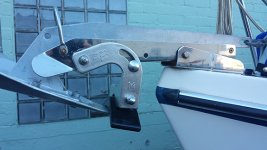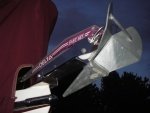tparrent
New member
- Joined
- Dec 23, 2009
- Messages
- 285
- Reaction score
- 0
- C Dory Year
- 2017
- C Dory Model
- 255 Tomcat
- Vessel Name
- Tomfoolery
I picked up my CD 22 from the shop today (fuel pickup in the second tank had deteriorated after replacing the other one in the spring) and as I hooked it up I saw a big chip of gelcoat down to the fiberglass about 6 inches above the bow eye.
I do not know when the damage occurred as I had not seen it when I hooked up the boat to take it to the shop. I use a valet launch service so I don't typically see the front of the boat. The damage could have been at the shop, while retrieving the boat or while retrieving the anchor.
I have a guy fixing the damage but I want to protect that area from future damage as well.
I have looked through the forum and seen a couple of suggestions from a few (and more than a few) years ago. I'm wondering if anyone has updated thoughts.
I would like to protect the bow against anchoring or trailering mishaps so the shield should probably go all the way from the bow eye up. I've also thought about a keel protector for beaching though I don't do that often.
I won't be doing the work myself (because I am really bad at boat work!) but would like an installation that is reasonably easy so my boat storage guy can do it. That means no milling of aluminum or other fancy stuff. He can certainly work with epoxy or self adhesive.
Thanks!
I do not know when the damage occurred as I had not seen it when I hooked up the boat to take it to the shop. I use a valet launch service so I don't typically see the front of the boat. The damage could have been at the shop, while retrieving the boat or while retrieving the anchor.
I have a guy fixing the damage but I want to protect that area from future damage as well.
I have looked through the forum and seen a couple of suggestions from a few (and more than a few) years ago. I'm wondering if anyone has updated thoughts.
I would like to protect the bow against anchoring or trailering mishaps so the shield should probably go all the way from the bow eye up. I've also thought about a keel protector for beaching though I don't do that often.
I won't be doing the work myself (because I am really bad at boat work!) but would like an installation that is reasonably easy so my boat storage guy can do it. That means no milling of aluminum or other fancy stuff. He can certainly work with epoxy or self adhesive.
Thanks!




